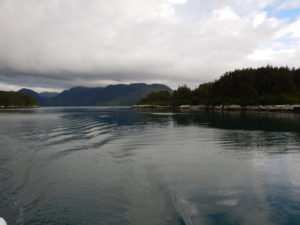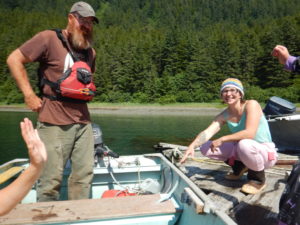The Hobbit Hole had been named by Zach Brown‘s mother back in the 1980s. At the time, she was a deck hand on one of the fishing boats that regularly found shelter and community during the summer fishing season, when Icy Strait was a major commercial fishery. (Sadly, no more.)

Approaching the Hobbit Hole. If you didn’t know it was there, you wouldn’t know it was there.
It was popular because of its extraordinarily sheltered bay, accessible by a small boat or skiff through a narrow “gut”. Fishing boats can enter in a high tide, skiffs when the tide is low. The tidal exchanges in the north land are large to huge, so when the tide is running strong in either direction, it makes for an engine straining ride and a vigorous (to impossible) paddle in the opposing direction.

The “Gut” looking out of the Hobbit Hole.
We shuttled ourselves and our gear and beer through the “gut” in 4 or 5 trips, greeted at the Hobbit dock by a young girl in a life jacket and two large, boisterous dogs. This was the family of the Inian Islands Institute caretakers, Colton and Lexie.

Colton and Lexie, caretakers of the Hobbit Hole.

Inside the Hobbit Hole, looking out at the dock.

Lexie’s “caboose” and lovely daughter.
Colton and Lexie served up truly amazing food all week long, no small challenge when fresh food can be a rarity in isolated communities. We ate wild-caught meat, garden greens, foraged plants from seashore and field. Every. Single. Meal. Fresh sourdough bread, waffles, biscuits, pancakes and even chocolate chip cookies! Homemade yogurt.
Once we and our gear made it up the boardwalk, we toured the facility. There was a plumbed “guest house” for anyone with mobility issues. Then the essential “shop”packed full of “fixits” that every homestead in remote AK must have in order to keep things working with expert “fixers” are far flung and expensive to bring in. Upstairs of the shop was a library filled with great reading material and !a pool table! (soon to become a convertible ping pong table…)

Our youngest staff member showing off the recently painted art in the “guest house”.
The third building housed the kitchen, dining and living and lecture room, with caretaker living quarters on the second floor.
Tucked into the bluff overlooking the bay was the bunk house and spacious living room area where the majority of us would stay. A few of us opted to pitch our tents in various secluded or convenient locations.
I was one of the tent pitchers, and after the first couple of nights, my back remembered that it could be happy even on a thermarest on medium hard ground. Although bears are always possible, since they do know how to swim, there is no resident bear population in the Inians. Environmental awareness and good food hygiene are ALWAYS a good idea, though. No bear scat, no rub trees, no bear belly or digging holes were evident.
We were up and ready for class after a world class breakfast. Class started at 9 each morning with a discussion about John Muir meeting the Tlingits as described in Dan Henry’s book, Across The Shaman’s River. Dan and Zach traded off packing our brains full of rhetoric technique and natural history, and finally, composing and practicing our presentations around a campfire. Our schoolin’ seldom ended before 10pm. We topped off the long days with singing and playing music, members of the group slowly peeling off to bed according to our individual stamina. Daylight came early, around 3am and it was never completely pitch dark. So goes the long Alaskan days of summer.
Sounds like a very special place for a retreat or to strategize an advance.
Ooh, thank you for taking me back to my heart space on this planet!
Yes, isn’t it though? Thanks for reading, Nancy!